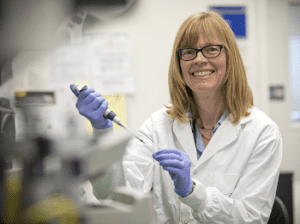Published: Friday, October 18, 2019, 5:35 p.m. U.S. Eastern Time
Media Contact: Nalini Padmanabhan, 301.634.7346, press@ashg.org
Findings Reported at ASHG 2019 Annual Meeting

(courtesy Dr. Nutter)
HOUSTON, Texas – Scientists are finding new ways to improve the use of the CRISPR enzyme Cas9 and reduce the chances of off-target mutations in laboratory mice, according to new results from a research collaboration including Lauryl Nutter, PhD, Senior Director, Science and Technology Development at The Centre for Phenogenomics at The Hospital for Sick Children (SickKids) in Toronto. The findings, which help scientists contextualize a common concern related to gene editing and identify new strategies to improve its precision, were presented as a featured plenary abstract at the American Society of Human Genetics 2019 Annual Meeting in Houston.
Dr. Nutter and her collaborators from the multi-institution Knockout Mouse Phenotyping Project (KOMP2) regularly use Cas9 and gene editing to produce lines of laboratory mice with specific mutations. In this work, they often encounter questions about the likelihood of off-target mutagenesis – unintended genetic mutations introduced by the gene editing process – in their mouse lines.
“We wanted to know: to what extent do we need to worry about off-target mutagenesis?” Dr. Nutter explained. By demonstrating the degree of the problem in mice, the researchers hoped to be better able to evaluate it in human cell lines being studied in the laboratory, as well as generate new ways to improve the precision of Cas9-based gene editing.
To answer these questions, Dr. Nutter’s team performed 58 genome editing experiments in mouse embryos with Cas9 and guide RNAs configured to induce a specific, targeted mutation in a different gene, which would be passed down to its descendants. Two to four guides were used for each experiment for a total of 175 different guide RNAs. They then sequenced each mouse’s whole genome to search for any additional mutations that may have resulted. To get a baseline rate of mutation, the whole genomes of Cas9-treated mouse lines were compared to those of 25 untreated control mice.
In 31 of the Cas9-treated mouse lines, the researchers found zero off-target mutations, and in the remaining 20 lines, they found an average of 2.3 off-target mutations. In comparison, among both the treated and untreated mouse lines, they found an average of 3,500 naturally occurring, unique mutations in each animal.
“Surprisingly, these results show that the number of naturally-occurring mutations far exceeded those introduced by Cas9,” Dr. Nutter said. “They also show that when guide RNAs are properly designed, off-target mutagenesis is quite rare.”
The results also add context to the use of inbred laboratory mouse lines in genetics research and the assumptions that scientists make when using them.
“Historically, we have used inbred mouse lines to study genetics in mice because their genomes differed only at certain, defined places, and we’ve assumed that any difference between the mice is due to those differences,” Dr. Nutter explained. “However, we found that even among mice in the same litter, there could be thousands of naturally-occurring genetic differences.”
“Our results highlight the need to be cognizant of using Cas9 and other tools in a genome that may not be as well defined as we think,” she added.
As next steps, Dr. Nutter and her collaborators plan to explore whether enzymes that inhibit or enhance DNA repair can affect the rate at which new mutations arise. They also plan to examine the tradeoff between improving the efficiency of Cas9 mutagenesis and improving its precision. Given their focus on the production of laboratory mouse lines, the researchers hope their findings will inform the development of better guide RNAs, the short pieces of RNA that enable Cas9 to bind to its intended target and induce the intended mutation.
More broadly, they hope their findings will lead to better use of control groups and a more informed perspective on experimental design. They noted that this knowledge will be particularly important in gene editing research with potential therapeutic applications, including studies of the safety and efficacy of genetics-based therapies.
Media Interest: To learn more about Dr. Nutter’s work or set up an interview, please contact press@ashg.org to coordinate.
Reference: L Nutter et al. (2019 Oct 18). Abstract: Whole genome sequencing puts Cas9 off-target mutagenesis into the context of genetic drift. Presented at the American Society of Human Genetics 2019 Annual Meeting. Houston, Texas.
About the American Society of Human Genetics (ASHG)
Founded in 1948, the American Society of Human Genetics is the primary professional membership organization for human genetics specialists worldwide. Its nearly 8,000 members include researchers, academicians, clinicians, laboratory practice professionals, genetic counselors, nurses, and others with an interest in human genetics. The Society serves scientists, health professionals, and the public by providing forums to: (1) share research results through the ASHG Annual Meeting and in The American Journal of Human Genetics; (2) advance genetic research by advocating for research support; (3) educate current and future genetics professionals, health care providers, advocates, policymakers, educators, students, and the public about all aspects of human genetics; and (4) promote genetic services and support responsible social and scientific policies. For more information, visit: http://www.ashg.org.
6120 Executive Blvd, Suite 500 | Rockville, MD 20852 | 301.634.7300 | society@ashg.org | www.ashg.org
Connect with ASHG on Twitter (@GeneticsSociety) | Facebook | LinkedIn
